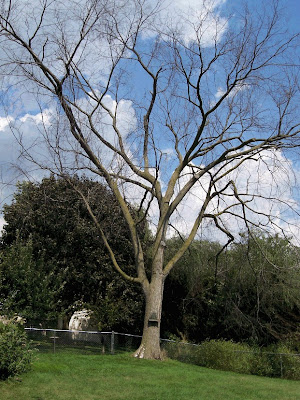I borrowed this from Jennifer
Under the Ponderosas, but I'm changing the title because there are already lots of Green Memes out there. There's no "Ethnobotany Meme" out there anywhere. What's ethnobotany, you ask? It's the relationship between people and plants. Yes, you do have a relationship with the plants around you, whether you know it or not. I'll write more about it someday.
Think of the plants (trees, flowers, etc) which grow within 50 yards of your home. Which is your favorite?
I hate to pick just one. How to chose between the violets I transplanted from my parent's house, where my grandmother planted them 70 years ago, and the jewelweed that attracts all of the hummingbirds every summer? What about all of those huge perennial swamp milkweeds that all came from a tiny seed packet, that attracted all those butterflies last year? How about the forsythia that my mother-in-law gave us? We pulled that bush out of the ground with our Honda hatchback when we moved out of our co-op townhouse, then left it frozen, wrapped in a garbage bag in our yard in here Saline when my daughter was born three weeks before her due date, and it still flourished when we planted it in the spring six months later.
I guess I have to pick the elm tree (Ulmus americana) that we just cut down, though. It was such a beautiful tree that shaded the whole back of our house from the morning sun and kept most of the backyard fairly cool until late afternoon.
Here it is two years after it was diagnosed with Dutch elm disease, getting the dead branches trimmed and just before its second injection with fungicide.
 Is any portion of this plant edible in any form? Can you boil the root, eat the berries, make tea from the leaves?
Is any portion of this plant edible in any form? Can you boil the root, eat the berries, make tea from the leaves?According to Dan Moerman's
Native American Ethnobotany database, different Indian groups used the inner bark in a variety of medicines, usually in a kind of tea (much like the related slippery elm bark as a cough remedy). I've never heard of anyone eating the seeds, which are papery and rather flat and not as interesting as most tree seeds.
Can you use any portion of this plant to make something that would be truly useful for you? Alternately, can you use any portion of this plant to make something just for fun, just one time?The wood was used by Native peoples and then later Americans for all kinds of things: house posts, tools, furniture, wagon wheels, sewage pipes. We have a big stack of wood that was cut for our fireplace, my son has attempted to make slingshots and various other toys from the smaller branches, and my husband has a stack of longer branches that he plans to use to damn the seasonal creek that borders our yard and the farm field behind.
Can this plant survive on the groundwater available to it, or does it need to be watered?It did fine on the water it got naturally, although we did water it and fertilize it after it became sick in an attempt to strengthen its fight against the fungus that the elm beetles brought.
Do you see any other creatures -- birds or bees or squirrels -- using this plant?A squirrel once took one of my sunflower heads and dropped pieces of it on me from this tree. I've seen squirrels eating the buds or the ends of twigs in the spring, too. And all kinds of birds have used the tree: crows liked to sit there in pairs, the occasional hawk used to watch our birdfeeders from the tree, and I've seen many flocks of starlings, and many nuthatches, downy woodpeckers, bluejays, robins, and cardinals up there.

After the tree died rather abruptly the summer before last, a whole new suite of creatures moved in. Weird fungi appeared, pieces of bark peeled off, and more woodpeckers and nuthatches than usual came - I guess that they were probably attracted to the insects that specialized in dead wood. My son pointed out this weird wasp-like thing last summer (when the tree had been dead a full year), which we identified as a giant ichneumons. Apparently it was laying eggs under the bark in the hidden galleries of larva tunnels. The Audubon guide said each egg would hatch and consume a horntail or some other wood-boring bug.

It is surprising how much the tree influenced our yard even when it was dead. It framed the landscape, it shed twigs that had to be picked up before we mowed, there were all the new and interesting creatures in it (more easily visible without leaves), it still provided some shade....it still had a certain presence.

I wish we could have watched it decay naturally, but it was too close to our house, and we got increasingly worried listening to it creak on windy days. Just before Christmas, the lumberjacks cut all the branches off it, toppled the trunk with a thud you could feel in the house (leaving an impressive dent in the soil), and ground the stump into a two foot high pile of mulch.

The tree's absence is still shocking....looking out at the moon rise, we see a gap where something always stood. The yard looks empty, the squirrels have to run a lot further to get away from our dog, and the pile of mulch looks disturbingly like a fresh grave.
What does this plant look like right now, during this season and at the time of day you're writing?
 Here's a piece of firewood, minus the bark. Pretty cool, isn't it?
Here's a piece of firewood, minus the bark. Pretty cool, isn't it?